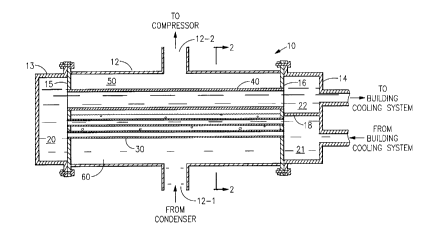Une partie des informations de ce site Web a été fournie par des sources externes. Le gouvernement du Canada n'assume aucune responsabilité concernant la précision, l'actualité ou la fiabilité des informations fournies par les sources externes. Les utilisateurs qui désirent employer cette information devraient consulter directement la source des informations. Le contenu fourni par les sources externes n'est pas assujetti aux exigences sur les langues officielles, la protection des renseignements personnels et l'accessibilité.
L'apparition de différences dans le texte et l'image des Revendications et de l'Abrégé dépend du moment auquel le document est publié. Les textes des Revendications et de l'Abrégé sont affichés :
| (12) Brevet: | (11) CA 2219699 |
|---|---|
| (54) Titre français: | ECHANGEUR DE CHALEUR A FAIBLE CHUTE DE PRESSION |
| (54) Titre anglais: | LOW PRESSURE DROP HEAT EXCHANGER |
| Statut: | Réputé périmé |
| (51) Classification internationale des brevets (CIB): |
|
|---|---|
| (72) Inventeurs : |
|
| (73) Titulaires : |
|
| (71) Demandeurs : |
|
| (74) Agent: | NORTON ROSE FULBRIGHT CANADA LLP/S.E.N.C.R.L., S.R.L. |
| (74) Co-agent: | |
| (45) Délivré: | 2002-08-13 |
| (22) Date de dépôt: | 1997-10-30 |
| (41) Mise à la disponibilité du public: | 1998-05-21 |
| Requête d'examen: | 1997-10-30 |
| Licence disponible: | S.O. |
| (25) Langue des documents déposés: | Anglais |
| Traité de coopération en matière de brevets (PCT): | Non |
|---|
| (30) Données de priorité de la demande: | ||||||
|---|---|---|---|---|---|---|
|
Cette invention concerne un échangeur de chaleur à deux parcours. Le premier parcours, en mode évaporateur, se fait dans une série de tubes immergés dans un frigorigène liquide. Ce liquide extrait la chaleur de l'eau qui circule dans lesdits tubes et se vaporise durant le processus. Le deuxième parcours se fait dans un tube unique qui n'a pas besoin d'être immergé dans le frigorigène liquide. L'objet de l'invention peut aussi servir de condenseur.
A two pass heat exchanger is provided. The first pass includes a plurality of tubes
located in liquid refrigerant, when employed as an evaporator, whereby the liquid
refrigerant draws heat from the water flowing through the tubes causing the water to
be cooled and the liquid refrigerant to evaporate. The second pass is a single pipe
which need not be located in the liquid refrigerant. The two pass heat exchanger can
also be used as a condenser.
Note : Les revendications sont présentées dans la langue officielle dans laquelle elles ont été soumises.
Note : Les descriptions sont présentées dans la langue officielle dans laquelle elles ont été soumises.

Pour une meilleure compréhension de l'état de la demande ou brevet qui figure sur cette page, la rubrique Mise en garde , et les descriptions de Brevet , États administratifs , Taxes périodiques et Historique des paiements devraient être consultées.
| Titre | Date |
|---|---|
| Date de délivrance prévu | 2002-08-13 |
| (22) Dépôt | 1997-10-30 |
| Requête d'examen | 1997-10-30 |
| (41) Mise à la disponibilité du public | 1998-05-21 |
| (45) Délivré | 2002-08-13 |
| Réputé périmé | 2009-10-30 |
Il n'y a pas d'historique d'abandonnement
| Type de taxes | Anniversaire | Échéance | Montant payé | Date payée |
|---|---|---|---|---|
| Requête d'examen | 400,00 $ | 1997-10-30 | ||
| Enregistrement de documents | 100,00 $ | 1997-10-30 | ||
| Le dépôt d'une demande de brevet | 300,00 $ | 1997-10-30 | ||
| Taxe de maintien en état - Demande - nouvelle loi | 2 | 1999-11-01 | 100,00 $ | 1999-09-15 |
| Taxe de maintien en état - Demande - nouvelle loi | 3 | 2000-10-30 | 100,00 $ | 2000-09-20 |
| Taxe de maintien en état - Demande - nouvelle loi | 4 | 2001-10-30 | 100,00 $ | 2001-10-02 |
| Taxe finale | 300,00 $ | 2002-05-28 | ||
| Taxe de maintien en état - brevet - nouvelle loi | 5 | 2002-10-30 | 400,00 $ | 2003-08-22 |
| Taxe de maintien en état - brevet - nouvelle loi | 6 | 2003-10-30 | 350,00 $ | 2004-05-13 |
| Taxe de maintien en état - brevet - nouvelle loi | 7 | 2004-11-01 | 200,00 $ | 2004-09-24 |
| Taxe de maintien en état - brevet - nouvelle loi | 8 | 2005-10-31 | 400,00 $ | 2005-12-14 |
| Taxe de maintien en état - brevet - nouvelle loi | 9 | 2006-10-30 | 200,00 $ | 2006-09-20 |
| Taxe de maintien en état - brevet - nouvelle loi | 10 | 2007-10-30 | 250,00 $ | 2007-09-21 |
Les titulaires actuels et antérieures au dossier sont affichés en ordre alphabétique.
| Titulaires actuels au dossier |
|---|
| CARRIER CORPORATION |
| Titulaires antérieures au dossier |
|---|
| HUENNIGER, EDWARD A. |